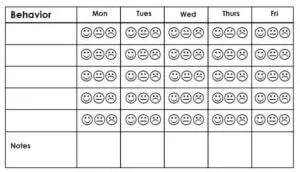When my 8-year-old started having behavior issues at school, it became clear pretty fast that discipline wasn’t enough. It didn’t matter how much he was grounded or how many privileges he lost. Extra chores made no difference. I was really at a loss. Then I realized I was missing half of the equation. The negative reinforcement was there, but where was the positive? Part of me felt that a kid shouldn’t be rewarded for what he should be doing anyway, but the other part recognized that a kid his age just doesn’t see the reward in behaving at school yet. I couldn’t just let him continue to misbehave.
The next question was how to add positive reinforcement? His issues weren’t academic, he excelled at his work. It was all behavior. He’d get done, get bored, and start acting out. That’s harder to quantify than a simple “A” grade. The answer was in his toddler years—sticker charts. Sort of, I mean actual little star stickers are kind of little-kid for a big second grader, but behavior charts. I had a sit down with his teacher and we made some small printed daily behavior logs. We also agreed that allowing him to do work from the 3rd grade class (he was in a 2nd-3rd split) might help him from getting bored. The goal was to both challenge him more to keep him busy while rewarding better behavior.
How to make a behavior chart for older kids:
–Choosing behavior chart goals:
The first thing we needed to do was decide what we were rewarding. One option there is to single out the behaviors you want to stop and make the goal for the day on your behavior chart the opposite of that behavior. For example, if you don’t like your kiddo leaving their coat on the floor, “pick up after self” could be a goal. Another way, and the way we chose to go, was with time increments. In this case, morning, lunch, gym/music, recess, afternoon, and bus as he wasn’t having issues at home. You could also do an entire-day system, but for some kids that makes it feel fruitless, because one small mistake ruins the day.
-Explaining goals.
Ideally, the goals above should be discussed with your child. While it’s great to have a preconceived list you feel is necessary, let them weigh in on where they feel they’re struggling. It’s a great opportunity to see where your child might not understand that they’re doing wrong while possible finding causes/solutions to the poor behaviors they do have. It’s also a good time to make clear the expectations of each goal. What counts as success and failure? Your child needs to know the rules of the game to play.
-Choosing behavior chart rewards.
Even more important than allowing your child to help set goals is allowing them to choose the reward. Ask your child what they want to earn and then agree on an appropriate way to earn that. You could go with a set number of days with no missed goals or a certain number of successes. I chose to do 30-days worth of “smileys.” Each timeframe of his school day that he behaved as he should, he earned a smiley face. Anytime he didn’t, he got a frowny face, and a note at the bottom to me stating what went wrong. This also really helped me in knowing how he was doing so that we could communicate about it daily. A single frowny face didn’t blow the day, since for his reward he needed the equivalent of 30-days of smileys or 150. If he only got 3 or 4 in a particular day, it still contributed.
-Adjusting behavior chart goals and rewards.
We did discover that sometimes what he wanted was smaller. Maybe one time he’d want a trip to the movies as a family (which is expensive these days) or a $30 video game, both of those were 30-day rewards, but what if he just wanted some candy or an inexpensive toy? It’s important to make sure that the reward fits the work put in.
You’ll likely also have some adjustments as behaviors disappear or new ones are found. You might find that your time-to-earn-reward span is too long, and your child just loses interest. It’s ok to tweak it until it works. Things don’t have to be set in stone, but avoid giving in so to speak. If your child doesn’t earn a reward, you can’t give it to them anyway for trying. Participation rewards are a bad idea when trying to change behavior with positive reinforcement.
I was impressed—and so was my son’s teacher—with how effective his behavior chart really was. She said it was like he was a different kid. Naturally how well a behavior chart will work for your child will really depend on personality, but it’s worth a shot if nothing else is working.

